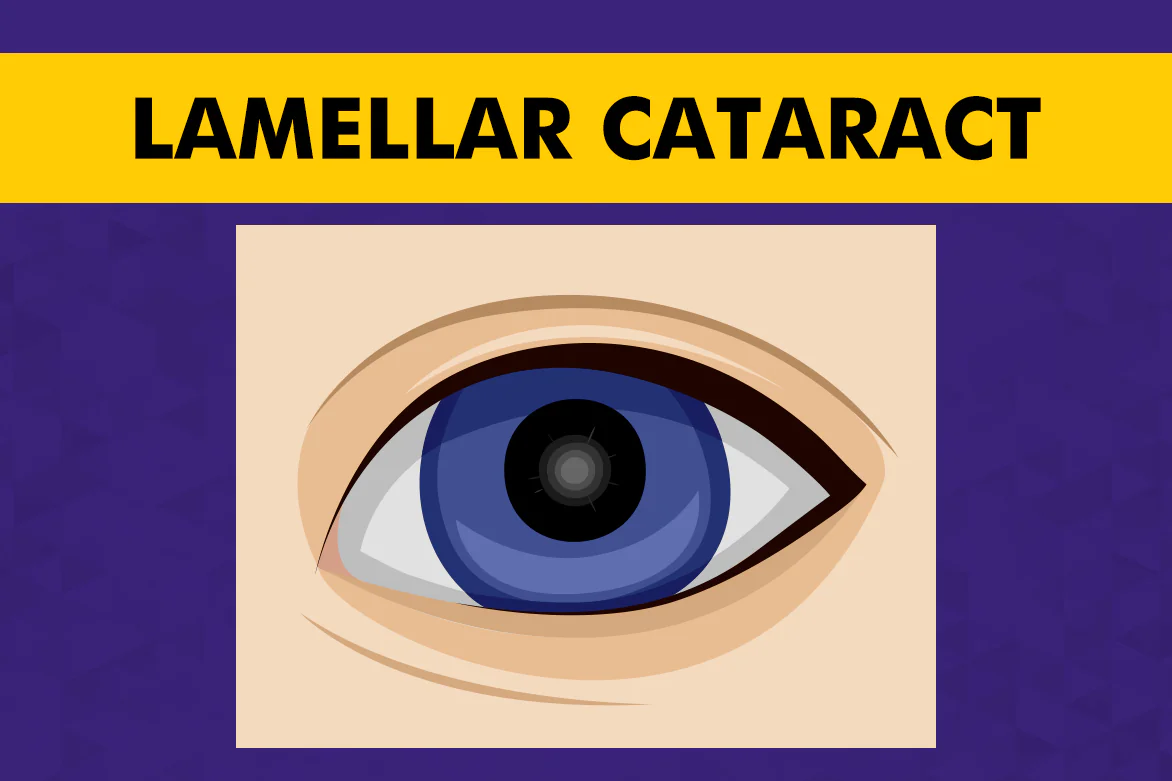Lamellar cataract, also referred to as zonular cataract, is a specific type of cataract that affects the lens of the eye. It is characterized by the formation of opaque areas within the lens, leading to visual impairment. This condition can occur in both children and adults, and it may affect one or both eyes.
In this blog, we will delve into the details of congenital lamellar cataract, including its lamellar cataract causes, symptoms, diagnosis, treatment options, and more. By gaining a better understanding of this condition, individuals can be better equipped to recognize the signs and seek appropriate medical attention.
What Is Lamellar or Zonular Cataract?
Zonular cataract is a type of congenital cataract, meaning it is present at birth or develops during infancy. It is characterized by the formation of cloudy or opaque areas within the lens. These opacities can vary in size and location, and they can affect different layers of the lens.
The exact cause of lamellar cataract is not fully understood. However, it is believed to be primarily caused by genetic factors. Certain mutations or abnormalities in the genes responsible for lens development can lead to the formation of zonular cataracts. In some cases, environmental factors or underlying medical conditions may also contribute to the development of this condition.
Lamellar cataracts can vary in severity. In some cases, they may only affect a small portion of the lens, leading to minor visual impairment. In more severe cases, the opacities can cover a larger area of the lens, resulting in significant vision loss.
It is important to note that zonular cataracts are not progressive. This means that once the opacities have formed, they usually do not worsen over time. However, the impact on vision can vary depending on the size and location of the opacities.
Zonular or Lamellar Cataract Causes
As mentioned earlier, lamellar cataract is primarily caused by genetic factors. It is often inherited in an autosomal dominant pattern, which means that a child has a 50% chance of developing the condition if one of the parents carries the gene mutation.
In some cases, zonular cataracts may also occur sporadically, meaning there is no family history of the condition. These cases may be caused by new gene mutations or other unknown factors.
Additionally, certain environmental factors or medical conditions may increase the risk of developing zonular cataract. These factors can include exposure to radiation, maternal infections during pregnancy, or certain metabolic disorders.
Lamellar Cataract Symptoms
The signs and symptoms of lamellar cataract can vary depending on the size and location of the opacities within the lens. Some common signs and symptoms include:
– Blurred or cloudy vision
– Reduced visual acuity
– Sensitivity to light
– Poor night vision
– Strabismus (crossed or misaligned eyes)
– Nystagmus (involuntary eye movements)
It is important to note that these symptoms may not be exclusive to zonular cataracts and can also be present in other eye conditions. Therefore, it is crucial to consult with an eye care professional for a proper diagnosis.
How Is Lamellar Cataract Diagnosed?
Diagnosing zonular cataracts typically involves a comprehensive eye examination. The eye care professional will perform various tests to assess visual acuity, evaluate the lens, and determine the presence of any opacities.
One common diagnostic tool used is a slit-lamp examination, which allows the doctor to examine the structures of the eye, including the lens, under magnification. Additional tests, such as visual field testing or optical coherence tomography (OCT), may also be conducted to gather more information about the condition.
If congenital lamellar cataract is suspected, the eye care professional may refer the individual to a pediatric ophthalmologist or a specialist in cataract surgery for further evaluation and management.
How to Prevent Lamellar Cataracts?
Since zonular cataract is primarily caused by genetic factors, there are currently no known prevention methods to avoid its development. However, early detection and appropriate management can help minimize the impact on vision and overall quality of life.
In cases where the visual impairment is significant and affects daily activities, cataract surgery may be recommended. During this procedure, the cloudy lens is removed and replaced with an artificial lens called an intraocular lens (IOL). Cataract surgery is generally safe and effective, with high success rates in improving vision.
Regular follow-up appointments with an eye care professional are important to monitor the condition and ensure optimal visual outcomes. Additionally, individuals with zonular cataracts should protect their eyes from excessive sunlight exposure and maintain a healthy lifestyle to support overall eye health.
Know the Tips to Prevent Cataract
Complications and Prognosis in Lamellar Cataract
Lamellar cataract itself does not typically lead to complications. However, the impact on vision can vary depending on the size and location of the opacities within the lens. In some cases, individuals with zonular cataract may experience visual impairment that affects their daily activities and quality of life.
The prognosis for congenital lamellar cataract is generally favorable, especially with appropriate management and timely cataract surgery if necessary. With advancements in surgical techniques and intraocular lens technology, the majority of individuals with zonular cataracts can achieve improved vision and lead fulfilling lives.
Curious to know about the Myths and Facts about Cataracts?
Treatment Options for Lamellar Cataract
The main treatment option for lamellar cataract is cataract surgery. This procedure involves removing the cloudy lens and replacing it with an artificial intraocular lens (IOL). Cataract surgery is a safe and effective procedure, with high success rates in restoring vision.
Read the Types of Intraocular Lenses blog to get more insights
The specific surgical approach and choice of intraocular lens depend on various factors, including the individual’s age, overall eye health, and the severity of the cataract. The surgeon will discuss the options and potential risks and benefits with the individual prior to the surgery.
In some cases, cataract surgery may be combined with other procedures, such as the removal of additional lens opacities or the correction of refractive errors with laser vision correction techniques.
Summary
Congenital lamellar cataract, also known as zonular cataract, is a specific type of cataract characterized by the formation of opaque areas within the lens. It can affect individuals of all ages and may be caused by genetic factors, environmental factors, or underlying medical conditions.
Signs and symptoms of lamellar cataract can include blurred vision, reduced visual acuity, sensitivity to light, and poor night vision. Diagnosis involves a comprehensive eye examination, and treatment options include cataract surgery to replace the cloudy lens with an artificial intraocular lens.
FAQs
What is lamellar cataract?
Lamellar cataract is a type of cataract where opacity occurs in a layer of the lens, affecting vision.
What are the types of Nystagmus?
Types of nystagmus include congenital nystagmus, acquired nystagmus, and periodic alternating nystagmus.
What are the common symptoms experienced by individuals with lamellar cataract?
Common symptoms of lamellar cataract include blurred vision, decreased visual acuity, and difficulty seeing in low light conditions.
What are the primary causes and risk factors associated with lamellar cataract?
Primary lamellar cataract causes can include genetic factors, congenital conditions, or ocular trauma, while risk factors may include family history and certain medical conditions.
How is lamellar cataract diagnosed by healthcare professionals?
Healthcare professionals diagnose lamellar cataract through a comprehensive eye examination, including visual acuity tests, slit-lamp examination, and imaging studies.
Are there any non-surgical treatment options available for managing lamellar cataract?
Non-surgical treatment options for managing lamellar cataract are limited, and surgery is typically the primary intervention to restore vision.
What is the difference between nuclear cataract and lamellar cataract?
The main difference between nuclear cataract and lamellar cataract lies in their location within the lens: nuclear cataract affects the center (nucleus) of the lens, while lamellar cataract involves a layer of the lens.





